One small, sleek, and powerful device instantly revolutionized wearable technology. Apple Watch, Garmin, Amazon Halo, and Fitbit have been dethroned.
Skip the thousand-dollar lab panels, invasive sleep studies, and uncomfortable fitness trackers. A device called the Oura Ring might provide everything you're looking for (and more). Share on XBut in 2022, with everything like the Apple Watch and WHOOP on the market, is the Oura Ring still worth it for YOU?
Maybe. It all comes down to what you’re looking for in a device. Overall the ring is great but not perfect. It’s one of the best all-purpose wearables. It does certain things well but it isn’t right for everyone.
Already have an Oura Ring but don’t know how to use it?
Check out my guide to Oura tips, tricks, and insights.
2024 Update: I upgraded to the newest version. While much of this remains the same, you’ll want to check out my Oura Ring V3 review & comparison post.
What is the Oura Ring?

The Oura disguises biometrics sensors in a stylish ring. Which is a trouble-edged sword:
I’d rather wear an inconspicuous ring than a huge watch or tracker. Then again, it’s still a ring and can get in the way — especially during sports.
You’ll find Oura represented in any gathering of biohackers.
Early adopters made suggestions to the original model, and the company listened. Version 2 dropped in 2018 and led the market by a landslide.
No advanced wearable has matched Oura’s success. It’s the de facto benchmark for newer devices like the Biostrap and Whoop. They give the Oura a run for its money, but years later it’s still a top pick.
Core Features of the Oura Ring
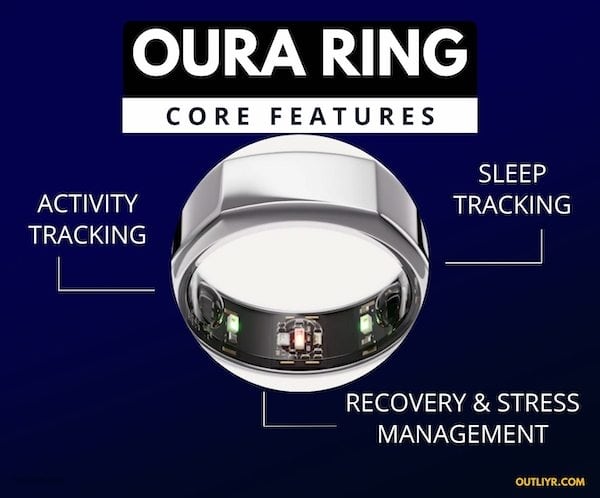
Sleep tracking

You go Oura for sleep data.
Their algorithm weight multiple biometrics into a single composite score. Metrics include: sleep latency, total sleep time, time in bed, sleep efficiency, resting heart rate, “restfulness”, light sleep, deep sleep, REM sleep, timing (consistent bedtime).
I’ve discovered quite a few correlations between my sleep and lifestyle:
- Drinking alcohol within an hour of sleep fragments the little sleep I get.
- My typical eight hours in bed usually translates to only about seven of real quality sleep. The rest is little micro-wakeups throughout the night. This really surprised me initially, but it seems accurate now that I’m aware.
- I nearly double my deep sleep when I exercise.
- Eating too close to bed prevents my resting heart rate from falling to optimal levels, impairing recovery.
- Heavy technology use late at night reduces deep sleep and total sleep (using the best blue light blocking software helps).
- Low-glycemic (“slow”) carbohydrates at dinner improve my overall sleep.
Activity tracking
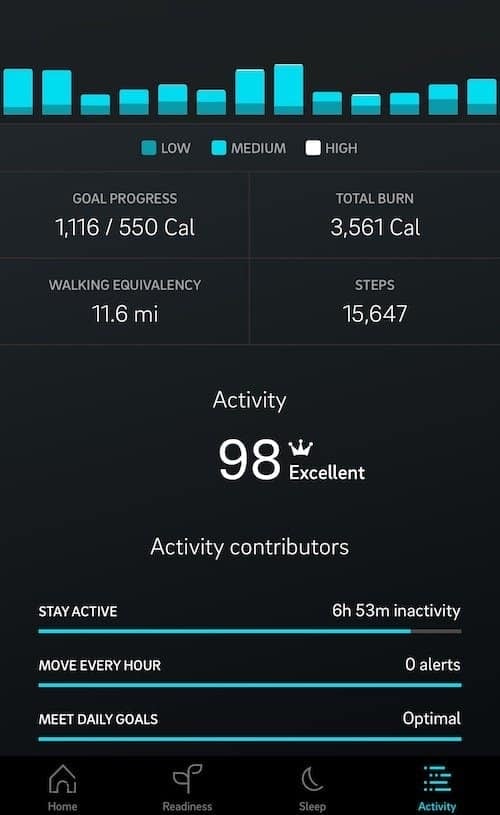
Oura’s movement tracking is minimal at best.
Movement and not workouts.
The Oura Ring activity tab quantifies:
- Total step count
- Calories burned
- Number of long sedentary periods
- Recovery
- Total inactivity time
- Activity goal progress
- Walking equivalent distance
- Training frequency
- Training volume
- Movement intensity
I’m not 100 percent satisfied with the activity tracking:
- Metric choice: “walking equivalent distance” shows your calories burned as a walking distance. I’d rather know how far I actually walked.
- Inconsistency: I don’t understand why “Stay Active” doesn’t follow a logical pattern. For example, today I logged 9:33 minutes of inactivity and the bar turned red. However, the other day 9:44 minutes of inactivity is somehow within the optimal range still (see the below photo).
- Subjective scoring: the “Recovery Time” metric punishes some forms of exercise more than others. According to Oura, most athletes will chronically be highly under-recovered.

Whoop, Biostrap, and my Garmin device all crush the Oura Ring for training purposes.
Recovery & stress management (Readiness)
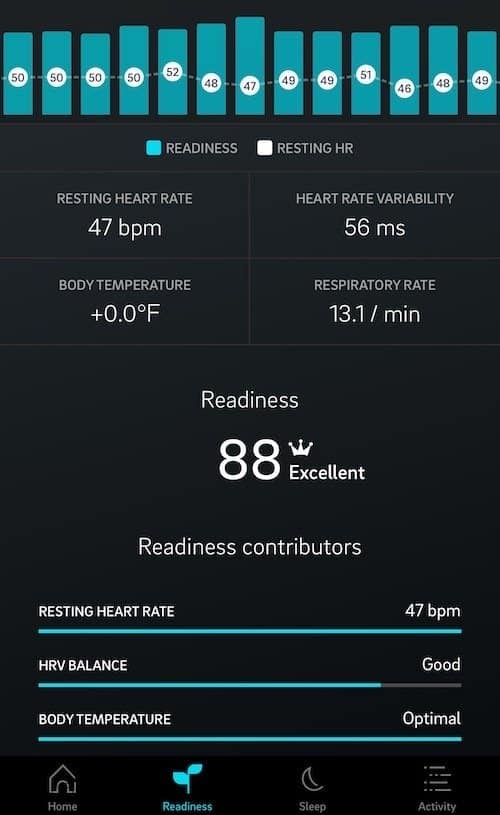
Recovery quantification quickly became my favorite part of the ring.
I don’t fully trust the sleep or activity tracking.
The recovery data is next-level.
Oura tracks the following recovery metrics:
- Resting heart rate (RHR)
- Heart rate variability (HRV)
- Body temperature
- Respiratory rate
- HRV balance
- Recovery index
- Previous night’s sleep
- Sleep balance
- Previous day’s activity
Each factor contributes to your overall readiness score for the day.
Recovery, sleep and lifestyle are closely related:
- Quality sleep improves virtually all measures of recovery.
- Grueling training brings down my HRV. Extreme cold/hot temperature exposures, meditation, breathwork, clean food, and healthy lifestyle practices improve it.
- Body temperature fluctuates about half a degree every night. But when I travel by plane it increases a full degree that night (easily observed in the app’s “trends”).
- I recover best when my resting heart rate drops early in the night. I do this by finishing workouts three or more hours before bed, reducing evening screen usage, and taking a cold shower 15-30 minutes before sleep.
- Processed carbohydrates or eating too close to bed jacks up my respiratory rate and resting heart rate by three to five beats per minute.
- Mouth taping improves my sleep quality and recovery scores. Even though I’m a nose breather.
Oura Ring Review: What I Love
Oura does a lot right.
Hardware evolves notoriously slowly. The company recently raised another series of funding. So I expect improvements to continue, or even pick up in pace.
From the ring design to software to analytics, I like the improvements I’ve seen over the last few years.
Minimalist
The first micro-wearable I saw.
I’ve owned Garmin’s, Apple Watches, Fitbits, an Amazon Halo, and even a Microsoft tracker. Most are an eyesore, uncomfortable, laughably inaccurate, or all of the above. The Garmin Fenix 5 currently on my wrist really feels like a mini-computer. So I was happy to find something smaller.
Every model Oura gets smaller and lighter. People stare in disbelief when I showcase my innocent ring’s biometric sensors.
Moment feature
Oura introduced the “Moment” feature in May 2019. After enough users requested on-demand heart rate variability (HRV) measurement, the company released a ring firmware and app update to accommodate.
What is HRV?
Your stress/relaxation level turned into a score. HRV measures your nervous system balance more accurately than any other available biometric. Since stress affects every part of you, I make sure to track HRV every single day (learn about HRV training here).
The ring always displays overnight HRV values. What’s useful, however, is to see the effects of everyday life on HRV. Until the “Moment” feature update, that wasn’t possible.
The update does what it claims. You choose a session type, duration, any background music, and the app measures HRV in the background.
No subscription
Wearables shouldn’t need subscriptions.
I’ve never considered owning the Whoop wearable simply because it requires a subscription. That’s right, on top of the sticker price, you’ll pay a monthly subscription for basic use.
I can’t see any reason that a wearable should require a subscription unless the extra data costs the company significant resources. Even then it doesn’t seem right.
Data trends

Every week, Oura prepares a progress report for you.
You receive a visual and quantified recap of your week. I can get through the entire thing in about a minute and spot trends.
- Are my workouts hampering my recovery?
- Has something happened to my sleep?
- Am I sticking to a stable sleep and wake-up schedule?
- Why do my stress levels always plummet in the latter half of the week?
Pull out the big guns using a special in-app tab called “Trends”. There you can drill down on any metric and visualize trends on a daily, weekly, or monthly basis. Perfect for getting quick answers to any hunches you have.
Easily slips off
Wearables are clunky.
Wrist straps take time and some fumbling to get on and off. Not the Oura, I can quickly slip it onto another finger in the blink of an eye and without much effort.
A minor but convenient detail.
Frequent software updates & reliable app
Hats off to their engineers.
The ring itself gets occasional firmware updates. My Oura app never crashes, And it regularly receives software updates.
Their updates introduce highly-anticipated new features.
Long battery life

Though my iPhone battery still barely survives through the evening, battery technology has grown tremendously.
Many of the leading wearables only slightly outlast my phone.
Not Oura. One single charge last me between five to six days, depending on how much I use the on-demand Moment feature.
Durable
This thing lasts.
I initially worried about the ring breaking. Since I do rough activities like rock climbing, exposure it to the intense temperatures of saunas and ice baths, and the impacts of motorcycling. I’ve banged it into all kinds of things. My Oura Ring has held up incredibly.
While I’ve managed to destroy three wrist wearables, in the same timeframe, this thing barely has a scratch.
Airplane mode
I’ll never buy a device without a way of disabling wireless signals.
Whether you believe in the damaging effects of non-native EMF, the precautionary principles warns that you’re better safe than sorry. Remember not long ago cigarettes, microwaves, and X-Rays, lead, asbestos weren’t considered harmful.
The most important basic step for EMR protection is to remove wireless devices, especially those touching the body.
Since wearables directly touch your skin all day long, I am careful. Taking precaution cannot hurt.
Cons of the Oura Ring
The Oura has it’s pitfalls.
Most of my criticism is nit-picky.
It’s a mediocre workout tracker.
Each section has it’s own composite score that comes from a unique weight of the page’s biometrics. On days with a lower score, I’d like to know which factors need improvement. It’s not clear which detract and how much.
Below are the rest.
Mediocre accuracy (but good for a wearable)
I have to get this out there: sleep stage tracking wearables aren’t accurate.
For a while, I took their readings as gospel. I’ve seen reports of users doing sleep studies in a lab while simultaneously wearing the Oura. Their sleep results weren’t even close.
Remember, the Oura is one of very few products that’s actually been clinically tested. The others are likely even less accurate.
Most devices are embarrassingly inaccurate. At least one study showed Oura having a 51-65 percent accuracy detecting sleep stages. From the vitals of your finger, the ring captures detailed biochemical changes — not an easy feat.
Users report that stationary activities like reading or watching TV can trick the ring into thinking you’re sleeping. Compared to actual sleep, this time isn’t restorative and harms your sleep score.
The accuracy isn’t all bad. Activity tracking, other sleep data, and recovery metrics hold up against my other devices.
Limited use For tagging data
Oura introduced a feature allowing you to tag days with specific notes.
Like “consumed coffee in the evening”, “travel”, “hot bedroom”, “stress”, or any things you’d want to track. Sounds like it could be useful, but it’s unintuitive. And you’re limited in the analyses you can perform with it.
I don’t know what I expected, but I haven’t heard of anyone using it.
On-demand measurements don’t work well
On-demand biometric measurement is a must-have.
And they’ve slightly improved the feature since Oura released their Moment feature. A recent update now shows how your skin temperature changes throughout sessions.
But you can’t see the values in real-time! So I’m stuck using my Garmin to track real-time HRV changes.
Moments only capture heart rate, HRV, and skin temperature. If the device moves even the slightest amount during a 20-minute recording session, you get zero HRV data.
Also, sometimes the app requires signal to re-download the Moment feature. If you’re without service, you’re out of luck (occasionally).
HRV training sessions don’t impact any overall scores either. You’d think that restorative breathwork would improve recovery (it does affect HRV).
Hard to size properly & inconsistent fit
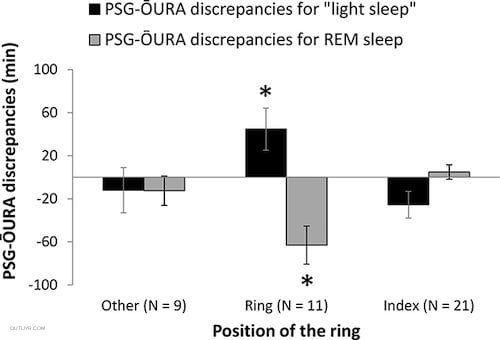
No fault of their own, but rings need sizing.
Any Oura wearer will tell you that fingers can dramatically change size throughout the day.
Sometimes I struggle to remove my ring. On others, it practically falls off.
I don’t know what happened, but my ring doesn’t quite fit like I thought it would. As a result, I primarily wear the ring on my thumb. It’s a different look than I expected, but I’m okay with it.
Sizing isn’t exactly seamless and makes the whole process from order to use longer.
Frequent data gaps

Sometimes I get bad data.
Occasionally I awaken to a sleep score in the 60s (out of 100). Thinking I slept well, I’m shocked. Then it dawns on me that the ring probably missed part of my sleep. Sure enough, I see large blank gaps throughout the night.
Now, this data becomes worse than useless. Artificially deflated Oura scores cause the nocebo effect: self-fulfilling low-energy, grumpy mood, impaired workout performance, and a larger appetite. There’s no way to delete days, so it complicates spotting trends later.
Inconsistent sleep data logging is my biggest complaint with Oura. I also haven’t come across with anyone with data gaps as bad as mine.
Subjective scoring algorithm
There’s a fine line between power and ease of use.
I disagree with Oura on some of their scoring algorithms.
Like the threshold of when certain values go from optimal to in the red. Especially when it comes to the “Recovery Time” metric.
Some metrics are not well thought out. If all my recovery metrics beat yesterday’s, and I slept more, why do I need more recovery time?
I know my tolerance and response to training. Sometimes I’ll go on a light recovery hike on a day off. I’ve noticed that even a light bike ride or walk around New York City can elevate my heart rate and absolutely destroy my recovery and activity scores. Even though I feel great and ready to train the next day, Oura tells me to rest.
Buggy workout importation
Not an issue if you only use the Oura, but it doesn’t play nice with other wearables.
I track my workouts and activity on my Garmin. I keep both devices in airplane mode whenever possible. I have to remember every night to manually sync the Garmin to my phone, and then open Oura to sync my workout.
This is one glaring flaw in it’s design:
The Oura ring can only import workouts the same day they occur. So, if at midnight, you sync a workout from earlier that day, Oura won’t count it. Ruining the accuracy of both your activity and recovery scores.
Expensive price
No wearable review is complete without a mention of price.
An understandable sticking point.
For $300, I expect a high-quality designer appliance. I would like them to use heartier materials.
Oura frequently runs promos, and I got mine for over $100 off.
Is it expensive? Yes. No doubt. I view it as an investment into my health and their R&D.
That said, I probably wouldn’t buy it at full price.
Oura Ring Frequently Asked Questions
How much is an Oura Ring?
The basic Heritage & Balance Oura Ring models retail for $299. Oura’s titanium Stealth model costs $399. Their premium Diamond model is $999. Sales of $50-$100 off MSRP are common.
Does the Oura Ring really work?
If you’re looking for detailed, reliable, accurate, and practical insight into your body, the Oura ring is one of the best wearables. This is among the toughest, most durable, and longest-lasting self-quantification devices available.
Is Oura Ring better than Apple Watch or Fitbit?
The Oura Ring does a great job tracking sleep, stress, recovery, and overall “readiness” for life. Unlike the others, Oura constantly tracks HRV throughout the night giving you the greatest detail. Although it measures basic movement, the Apple Watch and Fitbit do a better job of quantifying activity and workouts.
Should I wear my Oura Ring all day?
While not a requirement, Oura’s algorithms expect constant wear. For the most accurate scores and insight, Oura recommends wearing the ring as much as possible.
Does the Oura Ring measure blood pressure?
No. The Oura ring measures many biometrics but not blood pressure. However, it does measure Heart Rate Variability (HRV) and research shows a strong correlation between heart rate and blood pressure.
Which finger is best for Oura Ring?
A surprising study found that using the Oura Ring on the index finger and ring finger are often less accurate than others. But wear your Oura on whichever finger it fits best on. Not necessarily the ring nor index fingers.
Is the Oura Ring waterproof?
The Oura ring is water-resistant (up to up to 328 feet), but not fully waterproof. It can easily handle showers, baths, rain, and swimming. Unless you’re scuba diving you shouldn’t run into any issues.
Can you lift weights with Oura Ring?
In theory, yes. But it depends on the type of workout. I recommend against lifting weights, rocks, or sharp objects while wearing the ring. Barbells scratch the Oura Ring worst, followed by dumbbells, and then kettlebells.
Is the Oura Ring Worth It in 2022?
I’ve used my Oura for over four years now. It has treated me well.
I like it for basic activity tracking, and stress measurement. My sleep scores are iffy.
I lost mine kiteboarding in mid-2019 and their team gave me a sweet deal on a replacement (thank you!). The fact that I chose Oura again over the competition, shows my vote.
Yes, the Oura Ring is still worth it in 2022 for most people.
Overall the device is no magic bullet, but it gives me insight and accountability for each of my daily choices. In recent months I haven’t been as satisfied with my scores. I’ve been testing some promising alternatives.
Oura Ring Verdict: Still The King of Wearables?
I can’t stand clutter or bulky wearables strapped to my wrist.
Choose carefully. Half the value is the vast historical data records amassed over time. Each time you switch devices, you restart the data collection process. Oura has been around for years. They’re here to stay.
Go elsewhere for a standalone fitness tracker.
Accuracy is above most other devices. Still, spotting correlations between your lifestyle and biometrics takes data and practice to master.
For years,the Oura Ring has been my preferred device to track sleep and recovery (and movement as a bonus).
I think of the Oura as a window into your body. Sometimes haze (inaccurate data) obscures the inside picture, but watch it long enough and you’ll decode your inner workings.
Great similar biohacking wearables:
I’m in the middle of testing out the Biostrap. It provides more data, generates deeper insights, and is far better for activity tracking. So far I’m impressed.


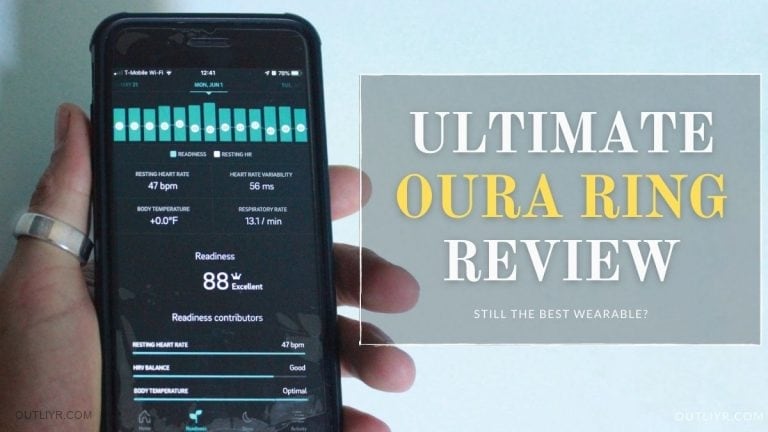

If you put like one of those silicone wedding rings over the oura ring while lifting weights to keep it from scratching, would that effect the accuracy of the sensors since they are inside.
That should help and wouldn’t disrupt the sensor… as long as your ring doesn’t lose contact with your skin. Good idea